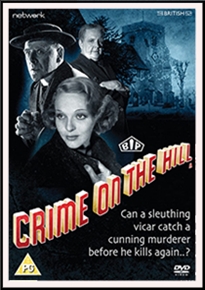November 2021
Monthly Archive
Tue 30 Nov 2021
Posted by Steve under
Reviews[5] Comments

ESTELLE THOMPSON – Find a Crooked Sixpence. Hodder & Stoughton, UK, hardcover, 1970. Walker, US, hardcover, 1977; paperback, 1984.
A flood-swollen river doesn’t quite produce a true “locked room” mystery, but when murder occurs in an isolated farmhouse the umber of possible suspects is thereby strictly limited.
The scene is Australia, and the detective is the new woman doctor in town. She finds herself attracted to the victim’s husband, the chief suspect in the eyes of the rest of the town. Beneath the overhand of fluttering feminine Gothicism is an iron core of real detection.
Rating: B
– Slightly revised from The MYSTERY FANcier, September/October 1978.
Bibliographic Update: While she wrote a total of 16 mysteries between 1961 and 2000, Estelle Thompson is surely all but forgotten today. All of her books take place in Australia; none of them include a continuing character.
Mon 29 Nov 2021
Posted by Steve under
Reviews[9] Comments
REVIEWED BY DAVID VINEYARD:
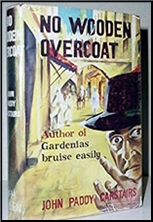
JOHN PADDY CARSTAIRS – No Wooden Overcoat. Garway Trenton #2. W. H. Allen, UK, hardcover, 1959. No US edition.
My fate seemed a foregone conclusion of torture and finally death, buried in the deep six in a land that wasn’t even my own — and perhaps not even a wooden overcoat.
Gar(way) Trenton, ex-Royal Navy pilot and successful novelist, is having a low point, all at sixes and sevens after a previous adventure that left him having nightmares of nearly being killed (I awoke screaming. I was dreaming I was back in the South of France and reliving my “holiday†there), but when a mysterious phone call from a man called Mr. Shadrach offers adventure he can’t resist.
“This is a Mister Shadrach here,†a voice said.
“Abednego here,†I retorted.
Mr. Shadrach represents Interpol (yes, this is the kind of book that thinks Interpol is an actual international police organization with agents and international authority — somebody watched too many episodes of The Man From Interpol with Charles Korvin) and Otto Von Scheidner, the Interpol agent Trenton met in his first adventure (Gardenias Bruise Easily). It seems there is a deadly drug smuggling ring in Tangier and every available Interpol agent has been blown.
Would Trenton like to help out, all expenses paid, him, with his Mauser Horace, his Aston Martin, and his buddy from his last adventure London Broker Ginger Bier (yes, Ginger Bier — it’s that kind of book)?
What two-fisted all-British kind of hero could pass up that kind of adventure?
Not this one, though he probably should have.
Once he and his Aston Martin arrive in Tangier things go steadily downhill. The Mr. Taghore from Interpol he is supposed to meet turns out to be one of the bad guys and the real Interpol agent set to meet him at the airport Captain Captain Edward Cuffley-Evans has been kidnapped by the opposition.
As the real Mr. Taghore explains Trenton has been blown, his mission over before he begins.
With twenty four hours to kill Trenton decides to visit a club where Ginger knows a girl who is performing, Fern La Verne — an arresting looking girl in her late twenties, pale and thin with large almond shaped eyes, and long fair hair. Fern (it’s a stage name, and yes, Carstairs fails basic Chandler/Fleming naming of exotic names) is tough but tender, but is she fair or foul is the question.
Fortunately he is better at character than names.
“…in life one spends a lot of time wishing for miracles.â€
“Ever get any?†She inquired.
“Oh, yes I’m a firm believer in miracles.â€
“I wish I was.â€
After a passionate kiss, he finds himself back in his hotel room where a tall stunning English blonde is waiting for him. Clare, wife of Captain Cuffley-Evans, who wants his help getting her husband back. She’s hiding something, but he isn’t sure what, but she is very beautiful and Trenton has decided to stay on and try to help not the least because he is attracted however guiltily to a married woman.
John Paddy Carstairs was a novelist, a successful artist, screenwriter, and perhaps best known as a director (1933-1970: The Saint in London, Sleeping Car to Trieste, several hit Norman Wisdom comedies, and two episodes of The Saint television series). With Gardenias Bruise Easily he turned to thriller writing with his hero Garway Trenton,who falls somewhere between James Bond and a Peter Cheyney protagonist with occasional forays into Bulldog Drummond.
Carstairs was also handsome, a musician, and had family in the film business (Anthony Nelson Keys) the lucky talented S.O.B..
In short order Trenton finds himself kidnapped by the opposition led by the sadistic Paul Garon (It was a handsome dissipated face, arrogant and cynical, and I could picture women being positively anxious for him to be contemptuous of them) and his smoother partner, the sinister mouthed Dragadore, the false Mr. Taghore who met with Trenton earlier.
Turns out they kidnapped Cuffley-Evans to have his wife assassinate Mr. Taghore for them, but now they have Trenton he seems a much better choice.
To conceive a plot on a way in which to kill a man — a man well protected — by remote control wasn’t easy. Then too I’d got to think up an antidote, as it were, to save him.
Two-fisted and fast with a gun, Trenton will win out in the end, but not without broken bones, knife wounds, and a few bullet holes worse for wear.
I’m divided on this one. I thoroughly enjoyed it, but whether anyone else would I can’t guess. Carstairs makes multiple faux pas as a thriller/suspense writer, but he obviously enjoys the genre, knows it pretty well, and his cinematic eye often makes this read more like a really good detailed scenario for a fun film than a novel.
Perhaps not surprising for the man who had a decent career as a director. (Other than Charteris, Carstairs is the only talent involved with both RKO’s The Saint series and the ITV version).
That cinematic reference is not a knock. It’s the quality that makes the book fun. I’ll be looking for Gardenias Bruise Easily, and wish there were more adventures of Gar Trenton. He’s a bit of a block head at times, talks a bit too much, but he’s a colorful guy and his creator nails the glamour, sex and violence, action, tongue in cheek, and exotic locales of the genre like an old pro.
Had he come along a few years later at the height of the Bond craze, Trenton might have had legs. As it is, he falls in that awkward era between Peter Cheyney and Ian Fleming where the British thriller was transitioning from the older Buchan/Edgar Wallace style to a more Americanized feel.
All I can say is I would read more of these if they were available and ultimately what more can you say about a thriller writer and series.
___
Editorial Note: You’re in luck, David. See below. (But how easily these may be found is another matter.)
The Garway Trenton series —
Gardenias Bruise Easily (n.) Allen 1958 [France]
No Wooden Overcoat (n.) Allen 1959 [Tangier]
Touch a French Pom-Pom (n.) Allen 1960 [France]
Pardon My Gun (n.) Allen 1962 [Corsica]
The Concrete Kimono (n.) Allen 1965 [Africa]
A Smell of Peardrops (n.) Allen 1966 [Tangier]
No Thanks for the Shroud (n.) Allen 1967 [Los Angeles, CA]
Sun 28 Nov 2021
I reviewed this story in my previous post on this blog, stating that I saw a couple of possible flaws in the solution. In the first comment to this followup post, I will attempt to explain why I wasn’t completely convinced. Please don’t read my comment until you’ve already read the story or if you don’t plan to anytime soon.
Responsible and even opposing points of view are, as always, welcome.
Sat 27 Nov 2021
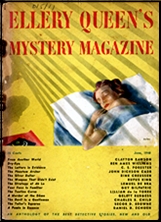
CLAYTON RAWSON “From Another World.†Novelette. The Great Merlini. First published in Ellery Queen’s Mystery Magazine, June 1948. Collected in The Great Merlini (Gregg Press, hardcover, 1979). Reprinted in The Quintessence of Queen, edited by Anthony Boucher (Random House, 19620; and Whodunit? Houdini?, edited by Otto Penzler (Harper & Row, 1976), among perhaps others.
I’m really of two minds with this one. On one hand, it has one of the cleverest ideas of how to set up a near-classic locked room mysteries. On the other, if you start to think about, the more and more you begin to think, “Would this really work?â€
Here’s the set-up: A wealthy man would like to believe that psychokinesis really works, but before he invests any money in a foundation to study it, he wants a full, hands-on demonstration. To that end, a noted female psychic agrees to these terms. Together alone in an otherwise empty room, she in a bathing suit, he across a desk from her, are to hold the equivalent of a seance. The edges of the only doorway are sealed with gummed paper tape.
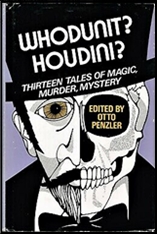
How then, when they become suspicious and break into the room, tearing the tape, do two men, The Great Merlini’s friend Ross one of them, find the man murdered, stabbed to death with a knife, the woman unconscious – not faked – and no knife to be found. Not only was the door locked, but it was sealed.
So far, so good, or even better. As an author, Rawson wasn’t quite as good as John Dickson Carr in setting up a certain atmosphere in a locked-room story which only adds to the mystery, but he comes close. Could something akin to the supernatural be responsible?
The answer is “no,†at least in this case, and if it wasn’t, what’s the fun in that? At first glance the solution is extremely simple — and indeed brilliant — but – and this is a huge “but†– if at story’s end, you start to realize that the story simply just couldn’t have happened the way Merlini susses it out, how then do you rate a story like that?
Sat 27 Nov 2021
REVIEWED BY DAN STUMPF:
LUKE SHORT – The Whip. Bantam #1668, paperback original, 1957. Reprinted by Bantam several times. Also: Dell, paperback, 1992. Previously published as a magazine serial; see below.
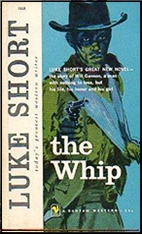
A short note after the copyright page tells us the first two-thirds of this was serialized in Colliers until that magazine went out of business, then the remainder was picked up by The Saturday Evening Post as a tribute to a fallen competitor. And to finish off a crackling fine yarn. (**)
Said yarn is of Will Gannon, the kind of tough westerner best suited to books like this, who, as the story opens, commandeers a stagecoach from a drunken driver, gets it safely to town, and ends up appointed District Manager of a stretch of road rife with robbery, murder, slack discipline and bad food.
The charm of this book is Luke Short’s ability to sketch out a tale of sudden violence against a background of the day-to-day work of running a business. He fills it in with a well-drawn cast of characters — mostly standard Western types, but well-drawn as such — and a convincing landscape for horses and men to travel and battle in.
But as I say, what makes The Whip work is the balance Luke Short strikes between Gannon’s workaday chores and the escalating violence engineered by the ne’er-do-wells he’s replaced. Short builds carefully, effectively, to a prolonged chase and a grim conclusion that rings true.
Definitely one for Western fans to check out!
___
(**) Steve and I have identified the first two parts of the three part serial:
“Doom Cliff,” (serial) Collier’s Dec 21 1956, Jan 4 1957 [last issue]
But the third and final installment supposedly published in The Saturday Evening Post has eluded us. Is the statement in the paperback edition incorrect? Have we missed something?
UPDATE: Mystery solved, thanks to the very kind assistance of pulp master Sai Shankar. See Comment #3.
Fri 26 Nov 2021
Posted by Steve under
Reviews[2] Comments
REVIEWED BY BARRY GARDNER:

CHANDLER: Stories & Early Novels and CHANDLER: Later Novels & Other Writings. Two-volume set. Library of America, hardcover, 1995.
If you, like me, think that any mystery collection is inadequate and incomplete without the works of Raymond Chandler; and you, like me, have acquired his books in mass paperback because you couldn’t afford them in hard covers; and you, like me, have harbored a forlorn wish to have them in a more permanent and respectable yet not outrageously expensive form; then here is what we’ve both been waiting for.

Since 1982 the Library of America, “an award-winning, non-profit publishing program dedicated to publishing America’s greatest writers in handsome, enduring volumes,” has been doing just that, and the Chandler set makes up the 80th and 81st volumes they have issued.
In the two volumes you’ll find all of Chandler’s novels, the thirteen short stories that he did not later incorporate into a novel, selected essays and letters, and the screenplay he wrote with Billy Wilder for Cain’s Double Indemnity. The 1199 and 1076 page volumes also each include notes and an excellent updated chronology of Chandler’s life by Frank McShane.
These are superbly produced books that bring the essence and essential works of Chandler together in an accessible and affordable form. At $35 the volume they represent as fine a value as you’re likely to find in the field in these days of $24 first novels and $7 paperbacks. If you don’t already own Chandler in hardcovers — and how many of us do? — you need to own these.
— Reprinted from Ah Sweet Mysteries #22, November 1995
Thu 25 Nov 2021
Thu 25 Nov 2021
Have a great day, everyone!

Wed 24 Nov 2021
Posted by Steve under
Reviews[8] Comments
REVIEWED BY MARYELL CLEARY:
EDEN PHILLPOTTS – “Found Drowned”. Hutchinson, UK, hardcover, 1931. Macmillan, US, hardcover, 1931.

When an itinerant musician is found dead in a cave near Daleham, the local police inspector and his friend, a retired doctor, differ about the case, The medical man takes it on himself to investigate what appears to be a simple case of suicide.
The search leads to the household of Sir Max Fordham, to a vanished dealer in antiques, and then to a serious question of identity. With a little help from Inspector Forbes, Dr. Meredith brings the case to a happy conclusion.
If we suspect that he has more good luck attending his footsteps than most detectives can boast, well, it’s his first case and perhaps he’s entitled to beginner’s luck!
– Reprinted from The Poison Pen, Volume 3, Number 4 (July-August 1980).
Bibliographic Note: In spite of Maryell’s hint that either Dr. Meredith and/or Inspector Forbes may have had further cases to investigate, there is nothing known to me to suggest they ever did. [Steve]
Wed 24 Nov 2021
REVIEWED BY DAVID VINEYARD:
CRIME ON THE HILL. British International Pictures, UK, 1933. Sally Blane, Sir Nigel Playfair, Lewis Casson, Phyllis Dare, Anthony Bushell. Screenplay by Vera Allison, E. M. Delafield, Bernard Vorhaus, Michael Hankinson. Based on a play by Jack Celestin and Jack DeLeon. Directed by Bernard Vorhaus.
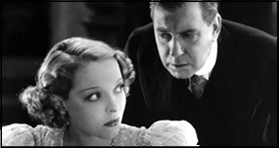
This little sleeper does show its age, but is a handsomely shot and intelligent old fashioned Golden Age fair play mystery with several nice touches that add up to a fairly taut and effecting ending and a genuine Great Detective moment done as nicely as I have ever seen, as a series of rapid flashbacks point out the things we may have missed or failed to properly give weight to, rather than a talky boring rehash of the case at a gathering of suspects.
The fact that this is based on a play and not a book is probably to its great advantage, as the dialogue is fairly sharp, and all the cues are hit on time.
The squire of a tidy little English village dies leaving his estate to his American ward Sylvia Kennett (Sally Blane), but from the start things start to go bad. Sylvia’s boyfriend Tony Fields (Anthony Bushell) won’t marry her because she is now rich, and then attractive middle aged friend Claire Winslow (Phyllis Dare) shows up with evidence she and the Squire were married, making her the heir.
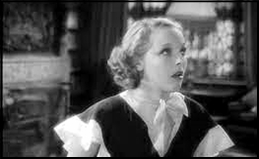
That’s no problem for Sylvia who can now marry Tony, but he still seems reluctant and is hiding something to do with the attractive maid.
Worse yet, the villagers are gossiping suggesting murder even though the Squire was being treated by Dr. Moody (Sir Nigel Playfair) for a terminal heart condition, and eventually the gossip gets bad enough Scotland Yard shows up with an exhumation order, the result of which shows the Squire was poisoned, the doctor missing it because his heart medicine had a small amount of cyanide in it.
Now unpleasant truths start coming out, and in short order Tony Fields finds himself arrested, tried, and convicted of murdering the old man, and as for the maid who was going to tell the police something when she was killed, it turns out she had his baby before he went off to University.
Detective work here is in the hands of Vicar David Grey (Lewis Casson), hunting and fishing buddy of Dr. Moody, and an old friend of the family. Upset that his little demi Paradise is concealing murder and other darker sins, the Vicar finds himself playing reluctant sleuth when a passing remark by a visitor at the Manor during a local open house accompanying a yearly charity affair puts him on the path to the shocking and unsettling truth about the Squire and his murder.
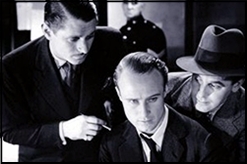
Replete with red herrings, colorful characters, alcoholic reporters, sensational headlines, flustered Scotland Yard men, dark secrets, darker revelations, a not too intrusive romance with a more interesting than usual couple, and a fine final set piece and beautifully shot little coda at the end this is an outstanding example of the form, and frankly works better and holds the interest better than many a better known mystery adaptation.
Bernard Vorhaus’s direction and cinematography by Claude Friese-Greene are both outstanding. A nightmarish fair ground is a particularly good set piece.
Only running an hour and three minutes, this one is well made with imaginative use of camera angles, camera tricks, and shadows to heighten the effect and dramatize the proceedings. The acting is better than usual and Casson as the unworldly but canny Vicar and Playfair his cynical medical friend are outstanding in what could easily have been merely comedy relief or preachy roles.
The final scene has real power, is imaginatively shot, and will hold the attention of even the most jaded mystery viewer.
You might find yourself comparing it to Marjorie Allingham’s Tiger in the Smoke in its portrayal of a truly good, but still interesting man confronted by human evil without losing his faith. I would have loved to have seen a Father Brown movie this well done.
Next Page »












